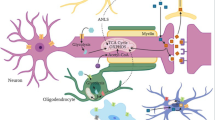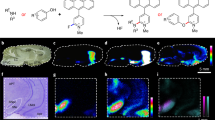Abstract
Purine metabolites have been implicated as clinically relevant biomarkers of worsening or improving Parkinson’s disease (PD) progression. However, the identification of purine molecules as biomarkers in PD has largely been determined using non-targeted metabolomics analysis. The primary goal of this study was to develop an economical targeted metabolomics approach for the routine detection of purine molecules in biological samples. Specifically, this project utilized LC/MS/MS and LC/QTOF/MS to accurately quantify levels of six purine molecules in samples from cultured N2a murine neuroblastoma cells. The targeted metabolomics workflow was integrated with automated label-free digital microscopy, which enabled normalization of purine concentration per unit cell in the absence of fluorescent dyes. The established method offered significantly enhanced selectivity compared to previously published procedures. In addition, this study demonstrates that a simple, quantitative targeted metabolomics approach can be developed to identify and quantify purine metabolites in biological samples. We envision that this method could be broadly applicable to quantification of purine metabolites from other complex biological samples, such as cerebrospinal fluid or blood.





Similar content being viewed by others
Abbreviations
- ADP:
-
Adenosine diphosphate
- AMP:
-
Adenosine monophosphate
- ANOVA:
-
Analysis of variance
- ATP:
-
Adenosine triphosphate
- CNS:
-
Central nervous system
- CSF:
-
Cerebrospinal fluid
- DI-ESI-MS:
-
Direct-infusion electrospray ionization mass spectrometry
- DL:
-
Detection limit
- DMEM:
-
Dulbecco’s Modified Eagle Medium
- ESI:
-
Electrospray ionization
- FBS:
-
Fetal bovine serum
- G6PD:
-
Glucose-6-phosphate-dehydrogenase
- GC-MS:
-
Gas chromatography-mass spectrometry
- HRMS:
-
High-resolution mass spectrometry
- ICH:
-
International Conference on Harmonization
- LC/MS/MS:
-
Liquid chromatography-tandem mass spectrometry
- LC/QTOF/MS:
-
Liquid chromatography-quadrupole-time-of-flight-mass spectrometry
- L-DOPA:
-
L-3,4-dihydroxyphenylalanine
- LLOD:
-
Lower limit of detection
- MRM:
-
Multiple reaction monitoring
- N2a:
-
Neuro-2a
- NADPH:
-
Nicotinamide adenine dinucleotide phosphate
- NMR:
-
Nuclear magnetic resonance
- NTPDase:
-
Ectonucleoside triphosphate diphosphohydrolase
- PD:
-
Parkinson’s disease
- QL:
-
Quantification limit
- QTOF/MS:
-
Quadrupole-time-of-flight-mass spectrometry
- UPDRS:
-
Unified Parkinson’s Disease Rating Scale
- UPLC:
-
Ultra performance liquid chromatography
- UV-vis:
-
Ultraviolet-visible spectroscopy
References
Poewe W, Seppi K, Tanner CM, Halliday GM, Brundin P, Volkmann J, Schrag AE, Lang AE (2017) Parkinson disease. Nat Rev Dis Primers 3:17013. https://doi.org/10.1038/nrdp.2017.13
Movement Disorder Society Task Force on Rating Scales for Parkinson’s Disease (2003) The unified Parkinson’s disease rating scale (UPDRS): status and recommendations. Mov Disord 18:738–750. https://doi.org/10.1002/mds.10473
Lamberts JT, Hildebrandt EN, Brundin P (2015) Spreading of α-synuclein in the face of axonal transport deficits in Parkinson’s disease: a speculative synthesis. Neurobiol Dis 77:276–283
Goldstein DS, Holmes C, Sharabi Y (2012) Cerebrospinal fluid biomarkers of central catecholamine deficiency in Parkinson’s disease and other synucleinopathies. Brain 135:1900–1913. https://doi.org/10.1093/brain/aws055
Havelund JF, Heegaard NHHH, Færgeman NJKK, Gramsbergen JB (2017) Biomarker research in Parkinson’s disease using metabolite profiling. Multidisciplinary Digital Publishing Institute
Burté F, Houghton D, Lowes H, Pyle A, Nesbitt S, Yarnall A, Yu-Wai-Man P, Burn DJ, Santibanez-Koref M, Hudson G (2017) Metabolic profiling of Parkinson’s disease and mild cognitive impairment. Mov Disord 32:927–932. https://doi.org/10.1002/mds.26992
Lewitt PA, Li J, Lu M et al (2017) Metabolomic biomarkers as strong correlates of Parkinson disease progression. Neurology 88:862–869. https://doi.org/10.1212/WNL.0000000000003663
Loeffler DA, LeWitt PA, Juneau PL et al (1998) Altered guanosine and guanine concentrations in rabbit striatum following increased dopamine turnover. Brain Res Bull 45:297–299
Ipata PL, Balestri F, Camici M, Tozzi MG (2011) Molecular mechanisms of nucleoside recycling in the brain. Int J Biochem Cell Biol 43:140–145. https://doi.org/10.1016/j.biocel.2010.10.007
Zimmermann H, Zebisch M, Sträter N (2012) Cellular function and molecular structure of ecto-nucleotidases. Purinergic Signal 8:437–502. https://doi.org/10.1007/s11302-012-9309-4
Linden JM (1999) Purine release and metabolism. In: Siegel GJ, Agranoff BW, Albers RW (eds) Basic neurochemistry: molecular, cellular and medical aspects, 6th edn. Lippincott-Raven, Philadelphia, pp 347–362
Burnstock G, Krügel U, Abbracchio MP, Illes P (2011) Purinergic signalling: from normal behaviour to pathological brain function. Prog Neurobiol 95:229–274. https://doi.org/10.1016/J.PNEUROBIO.2011.08.006
Ascherio A, LeWitt PA, Xu K et al (2009) Urate as a predictor of the rate of clinical decline in Parkinson disease. Arch Neurol 66:1460–1468. https://doi.org/10.1001/archneurol.2009.247
Schwarzschild MA, Schwid SR, Marek K, Watts A, Lang AE, Oakes D, Shoulson I, Ascherio A, Parkinson Study Group PRECEPT Investigators, Hyson C, Gorbold E, Rudolph A, Kieburtz K, Fahn S, Gauger L, Goetz C, Seibyl J, Forrest M, Ondrasik J (2008) Serum urate as a predictor of clinical and radiographic progression in Parkinson disease. Arch Neurol 65:716–723. https://doi.org/10.1001/archneur.2008.65.6.nct70003
Cortese M, Riise T, Engeland A, Ascherio A, Bjørnevik K (2018) Urate and the risk of Parkinson’s disease in men and women. Parkinsonism Relat Disord 52:76–82
Miao V, Oise Coë Ffet-Legal M-F, Brian P, et al (2018) Daptomycin biosynthesis in Streptomyces roseosporus: cloning and analysis of the gene cluster and revision of peptide stereochemistry. Sat 27:57. https://doi.org/10.1099/mic.0.27757-0
Dickey CA, De Mesquita DD, Morgan D, Pennypacker KR (2004) Induction of memory-associated immediate early genes by nerve growth factor in rat primary cortical neurons and differentiated mouse Neuro2A cells. Neurosci Lett 366:10–14. https://doi.org/10.1016/j.neulet.2004.04.089
Aragon-Martinez OH, Galicia O, Isiordia-Espinoza MA, Martinez-Morales F (2014) A novel method for measuring the ATP-related compounds in human erythrocytes. Tohoku J Exp Med 233:205–214
McFarland NR, Burdett T, Desjardins CA et al (2013) Postmortem brain levels of urate and precursors in Parkinson’s disease and related disorders. Neurodegener Dis 12:189–198. https://doi.org/10.1159/000346370
Drey LL, Graber MC, Bieschke J (2013) Counting unstained, confluent cells by modified bright-field microscopy. Biotechniques 55:28–33. https://doi.org/10.2144/000114056
Tremblay RG, Sikorska M, Sandhu JK, Lanthier P, Ribecco-Lutkiewicz M, Bani-Yaghoub M (2010) Differentiation of mouse neuro 2A cells into dopamine neurons. J Neurosci Methods 186:60–67. https://doi.org/10.1016/j.jneumeth.2009.11.004
Gómez-Villafuertes R, Pintor J, Miras-Portugal MT, Gualix J (2014) Ectonucleotide pyrophosphatase/phosphodiesterase activity in neuro-2a neuroblastoma cells: changes in expression associated with neuronal differentiation. J Neurochem 131:290–302. https://doi.org/10.1111/jnc.12794
Lei S, Zavala-Flores L, Garcia-Garcia A, Nandakumar R, Huang Y, Madayiputhiya N, Stanton RC, Dodds ED, Powers R, Franco R (2014) Alterations in energy/redox metabolism induced by mitochondrial and environmental toxins: a specific role for glucose-6-phosphate-dehydrogenase and the pentose phosphate pathway in paraquat toxicity. ACS Chem Biol 9:2032–2048. https://doi.org/10.1021/cb400894a
Acknowledgements
LC/MS/MS targeted metabolomics experiments were performed at the Michigan State University Mass Spectrometry and Metabolomics Core Facility headed by Professor Dr. Dan Jones. The authors thank Dr. Anthony Schilmiller and Mrs. Lijun Chen for their help in conducting mass spectrometry analysis.
Funding
This study was funded by a Ferris State University Exceptional Merit Grant to S.E.N. and an American Association of Colleges of Pharmacy New Investigator Award to J.T.L.
Author information
Authors and Affiliations
Contributions
All authors contributed to all aspects of experimentation and manuscript preparation.
Corresponding author
Ethics declarations
Conflict of interest
S. Eric Nybo declares that he has no conflict of interest.
Jennifer T. Lamberts declares that she has no conflict of interest.
Ethical approval
This article does not contain any studies with human participants or animals performed by any of the authors.
Additional information
Publisher’s Note
Springer Nature remains neutral with regard to jurisdictional claims in published maps and institutional affiliations.
Electronic supplementary material
ESM 1
(DOCX 37293 kb)
Rights and permissions
About this article
Cite this article
Nybo, S.E., Lamberts, J.T. Integrated use of LC/MS/MS and LC/Q-TOF/MS targeted metabolomics with automated label-free microscopy for quantification of purine metabolites in cultured mammalian cells. Purinergic Signalling 15, 17–25 (2019). https://doi.org/10.1007/s11302-018-9643-2
Received:
Accepted:
Published:
Issue Date:
DOI: https://doi.org/10.1007/s11302-018-9643-2




